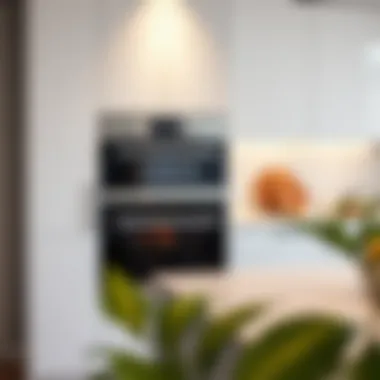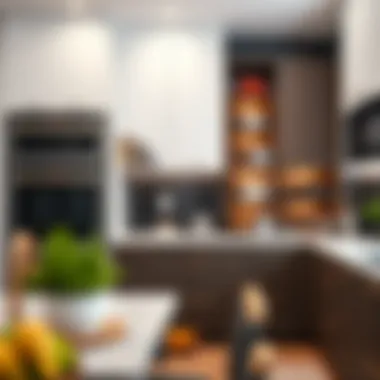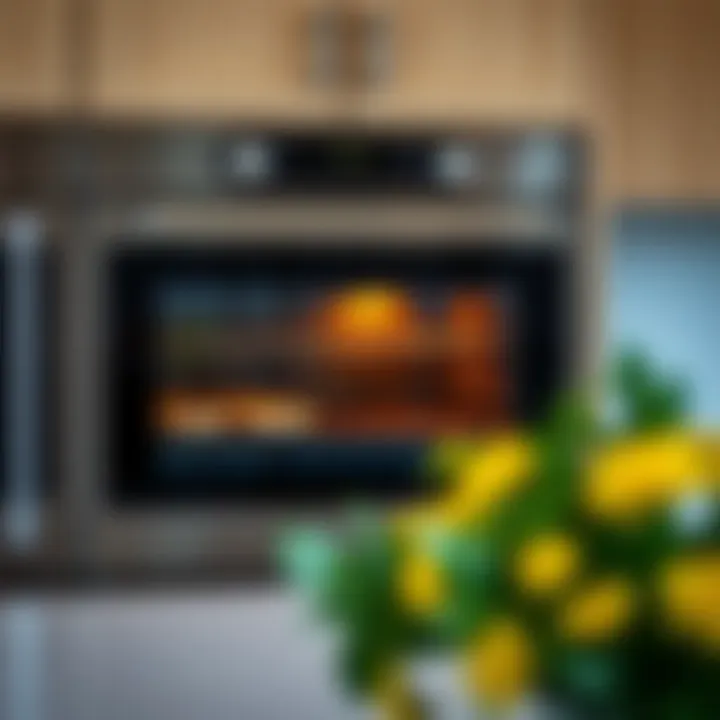Integrating Built-In Ovens: Enhancing Kitchen Design


Intro
The kitchen has evolved from a mere cooking space to the heart of the home, where functionality meets design. Built-in ovens have surged in popularity, not only for their convenience but also for the sleek, modern aesthetic they inject into the kitchen. Integrating a built-in oven into kitchen cabinetry is more than just a technical upgrade; it's a statement of style and sophistication. This article unpacks the multifaceted benefits of this integration, addressing essential themes like design inspiration, practical considerations, and maintenance tips.
By exploring contemporary trends in kitchen design, we aim to provide insightful guidance for homeowners, designers, and decorators alike. Whether you're dotting the i's and crossing the t's on a renovation plan or just embarking on conceptual designs, this guide is crafted to enhance your decision-making process and inspire innovative kitchen layouts.
Design Inspiration
The sight of a built-in oven can elevate the overall appearance of a kitchen, seamlessly blending with cabinetry that reflects personal style and trends. Understanding current design inspirations can make the difference between a cookie-cutter kitchen and a truly unique space.
Trending Furniture Styles
- Minimalism: This style emphasizes clean lines and uncluttered spaces. A built-in oven can be tucked within cabinetry, making it virtually invisible, aligning perfectly with the minimalist philosophy.
- Industrial: For those who appreciate a bit of grit, industrial style combines raw materials such as wood and metal. A stainless steel built-in oven complements this edgy aesthetic, making the kitchen feel both warm and modern.
- Farmhouse: This trend combines rustic charm with contemporary touches. Wall ovens in cabinetry featuring distressed finishes can effortlessly enhance the cozy, inviting feel of a farmhouse-style kitchen.
Color Palettes and Combinations
Color is key to conveying a desired mood in a kitchen. Integrating built-in ovens allows for a range of color choices.
- Bold Contrasts: Consider a dark blue cabinetry paired with a lighter stainless steel oven. The contrast draws the eye and adds depth to the design.
- Monochromatic: For a more subtle approach, uniform colors create a seamless look. Various shades of gray, for example, can make a kitchen feel harmonious.
- Accent Colors: A pop of color can transform the ordinary into the extraordinary. Imagine a bright red oven integrated into otherwise neutral cabinetry — it becomes an instant focal point.
"The kitchen should be a place of joy, where style and function coexist harmoniously."
Practical Advice
Owning a built-in oven isn't just about enjoying the aesthetics; it involves thoughtful planning and upkeep to get the most out of your investment. Let's explore some practical advice that can help guide homeowners and designers.
Furniture Maintenance Tips
Maintaining your built-in oven and surrounding cabinetry is essential:
- Regular Cleaning: Dust and grease can accumulate in hidden places, so a gentle wipe-down with appropriate cleaners is crucial.
- Check for Wear: Look at the hinges and handles frequently. They can wear out or loosen over time, especially if used regularly.
- Avoid Damp Areas: Ensure that cabinetry around the oven is not exposed to excess moisture, which could cause wood to warp.
Space Planning Solutions
When integrating a built-in oven, efficient space planning is key:
- Vertical Space: Utilize vertical space effectively. Installing the oven at eye level can enhance accessibility and make the cooking process smoother.
- Adjacent Workspaces: Position the oven near prep areas to streamline cooking tasks and minimize unnecessary movement in the kitchen.
- Consider Workflow: The kitchen work triangle — consisting of the stove, sink, and refrigerator — should remain unobstructed and intuitive for a functional design.
By keeping these design inspirations and practical insights in mind, it's possible to create a kitchen that is not only beautiful but also highly functional. Integrating built-in ovens into cabinetry can redefine cooking spaces, making them stylish and efficient for years to come.
Understanding Built-In Ovens
In today's kitchens, built-in ovens have transcended their purely functional role to become an integral part of overall design. Understanding built-in ovens is essential for anyone looking to enhance both the practicality and aesthetic appeal of their kitchen space. This understanding encompasses various aspects, including their definition, types, and how they fit into modern cabinetry.
A built-in oven is typically installed within custom cabinetry or wall units, saving valuable counter space while delivering cooking power and convenience. The seamless integration of these ovens into kitchen cabinets promotes a tidy and organized look in the culinary workspace. Not only do built-in ovens offer top-notch performance, they also elevate the aesthetic quality of the kitchen, merging into the design rather than standing out as separate appliances.
Definition and Overview
A built-in oven can be defined as an oven designed to be housed into kitchen cabinetry, flush with the surrounding elements. This design allows for efficient use of space, expanding the kitchen's overall functionality.
Unlike standard freestanding ovens, built-in models often feel like part of the kitchen's architecture. This allows designers and homeowners to focus more on achieving a cohesive look in the cooking area. On top of that, these ovens are available in various styles and configurations, which is crucial for those desiring a customized kitchen design.
Types of Built-In Ovens
Several types of built-in ovens cater to different cooking needs and preferences. Their choices can significantly influence both functionality and style in the kitchen. Here’s a closer look at some of the most popular types:
Single Ovens
Single ovens are often the most compact option, typically featuring one compartment where food is cooked. This design makes them a practical choice for smaller kitchens or apartments where space is at a premium. Their primary characteristic is simplicity—no frills, just straight to the cooking.
A key benefit of single ovens is their energy efficiency. They consume less power compared to larger models, making them economical for daily use. However, the limitation arises from its capacity; larger roasts or multiple trays can't be accommodated simultaneously, which could be a drawback for those who love to entertain or cook elaborate meals.
Double Ovens
Double ovens take versatility up a notch. As the name suggests, they consist of two separate compartments, allowing for multiple dishes to be cooked simultaneously at different temperatures. This feature is especially appealing for families or passionate chefs who handle various cooking tasks concurrently.
The often-seen advantage here is increased capacity and flexibility, where you can bake a pie in one chamber while roasting a chicken in the other. The downside? They tend to take up more space, requiring well-planned cabinetry to fit, making them less favorable for smaller kitchens.
Convection Ovens


Convection ovens stand out by using fans to circulate heated air, leading to a more even cooking process. This technology can significantly speed up cooking time, making it a favorite for those looking to save time in the kitchen.
The perk of a convection oven lays in its ability to achieve crispier results with less cooking time—perfect for roasting vegetables or baking pastries. However, they can require some cooking adjustments, as food may cook faster than in a conventional oven, which could leave some novice cooks scratching their heads.
Steam Ovens
Finally, steam ovens introduce a healthier cooking method, infusing steam into the cooking process. This is especially beneficial for retaining nutrients in vegetables, ensuring meals are not only delicious but also nutritious.
The unique feature of steam ovens is their ability to combine moisture with heat, resulting in tender food without the need for excessive fat. Whereas they shine in the health department, they also can lack the browning capabilities seen in traditional ovens, possibly limiting cooking options.
"The choice of built-in oven reflects not just cooking preferences but also the personality of the kitchen itself."
In closing, understanding the integration of built-in ovens in kitchen designs opens up a world of possibilities for homeowners and designers alike. Each type offers distinct advantages and specific uses that can greatly enhance kitchen functionality and aesthetics.
Benefits of Built-In Ovens
Integrating built-in ovens into kitchen cabinetry offers several significant advantages for homeowners and designers alike. These benefits range from improved space efficiency to enhanced cooking features and overall aesthetic value. In the cluttered landscape of modern kitchens, built-in ovens stand out as a practical solution that simplifies cooking and elevates design. Understanding these benefits is essential for anyone looking to create a functional yet stylish kitchen space.
Space Efficiency
One of the foremost advantages of built-in ovens is their contribution to space efficiency. Homeowners with smaller kitchens often struggle to find a balance between functionality and available space. This is where built-in ovens can shine. By merging the oven seamlessly with cabinetry, it eliminates the need for bulky freestanding units and can free up valuable floor space.
When a built-in oven is installed, it becomes part of the kitchen’s overall flow. Homeowners can utilize vertical space much more effectively, as these ovens can fit snugly under countertops or within specialized cabinetry. For instance, if you visualize a cabinet that houses an oven at eye level, it not only saves bending over but also enhances safety. With a well-placed built-in oven, the kitchen feels less cramped.
Furthermore, these ovens often come equipped with varying sizes, ensuring that each kitchen can find an optimal fit. This adaptability is key, as it allows for personalized layouts that cater to the needs of each household. Whether you're a cooking novice or a seasoned chef, understanding how to maximize space can transform the culinary experience.
Aesthetic Value
Beyond their functionality, built-in ovens bring significant aesthetic value to kitchen designs. In an era prioritizing sleek, contemporary looks, these ovens can be tailored to match any cabinetry style. Many designs now incorporate finishes that blend with wood, metal, or laminate, creating a unified and polished appearance.
When choosing a built-in oven, consider how it complements your cabinetry. Modern ovens often come with customizable features, such as a variety of color schemes and handle styles. For example, pairing a stainless-steel oven with dark wood cabinetry can create a striking contrast, adding depth to the kitchen atmosphere.
Additionally, built-in ovens provide an opportunity to showcase personal style. As they can be integrated into the overall kitchen design rather than merely standing out as an appliance, they contribute to a cohesive look. This integration often leads to enhanced property value, as potential buyers are drawn to homes with professionally designed kitchens. In a nutshell, investing in a built-in oven is not just about function; it's about creating a kitchen that reflects your lifestyle and aesthetic preferences.
Enhanced Cooking Features
Built-in ovens often come with enhanced cooking features that exceed what conventional models offer. For starters, many of these ovens include technology designed to streamline cooking processes. Features such as convection cooking, self-cleaning functions, and even smart technology integration make meal preparation not just easier but also more enjoyable.
Convection ovens, for example, use fans to circulate hot air, ensuring even cooking and browning, something regular ovens might struggle with. This consistency can significantly improve the quality of meals, making built-in ovens a favored choice among cooking enthusiasts.
Moreover, the convenience of technology in current built-in models cannot be understated. Smart ovens allow users to connect via smartphone, enabling them to monitor cooking temperatures, set timers, or even receive notifications when meals are done. This capability can be especially advantageous for busy families balancing meals with other responsibilities.
Overall, built-in ovens redefine the cooking experience, making it more intuitive and aligned with modern lifestyles. By considering the enhanced features, homeowners can choose models that cater precisely to their culinary needs.
Design Considerations for Kitchen Cabinets
When integrating built-in ovens into kitchen cabinetry, careful consideration of design elements is crucial. This not only ensures a harmonious look but also improves functionality and efficiency in the cooking space. From cabinet style compatibility to material selection and color schemes, there are several factors to contemplate that will enhance the overall success of the kitchen layout.
Cabinet Style Compatibility
Contemporary Designs
Contemporary designs are known for their sleek, clean lines and minimalistic approach. This style often emphasizes open space and functionality, making it a perfect match for built-in ovens. One of the key characteristics of contemporary cabinetry is the use of handleless designs, which not only looks modern but also allows for a seamless integration with appliances. By opting for contemporary styles, homeowners can benefit from a clutter-free aesthetic that highlights the oven's features without overwhelming the space.
A unique feature of contemporary designs is the emphasis on open shelving or glass-paneled cabinets that promote visibility and accessibility for everyday items. However, the downside might be the potential for fingerprints or smudges to become more visible on high-gloss finishes. Despite this, the sophisticated appearance and functionality often outweigh such minor concerns.
Traditional Styles
In contrast, traditional styles are about warmth and comfort. This design often incorporates rich woods, intricate moldings, and detailed finishes, making it a lasting choice for homeowners who prefer a more classic ambiance. The inviting character of traditional cabinetry can create a warm environment, providing a sense of nostalgia.
The hallmark of traditional styles is their custom craftsmanship, which can lead to stunning and unique kitchen designs. However, this can also mean a longer installation process and potentially higher costs. Nevertheless, these cabinets can become a focal point that accentuates the built-in oven’s charm while providing the functionality necessary in modern kitchens.
Material Selection
Wood Options
Wood options are timeless. Choosing wood for cabinetry not only offers a natural look but also provides durability. Common choices include maple, oak, and cherry, each bringing its own aesthetic and durability to the table. One prominent advantage of wood is its ability to be stained or painted, allowing for personalization and adaptability in various kitchen themes.
However, wood might require more regular maintenance than other materials, especially in terms of moisture resistance. This is essential to remember, particularly for those living in humid climates. Nevertheless, the characteristic warmth and beauty of wood often make it a preferred selection among homeowners.


Metal Finishes
When discussing aesthetic appeal and durability, metal finishes stand out. Their clean, modern look can complement built-in ovens beautifully, offering a contemporary edge. Stainless steel is a common choice, as it pairs well with most kitchen designs and is resistant to stains and heat, a critical aspect also valuable for maintenance in busy kitchens.
Yet, while metal finishes are stylish, they can also show fingerprints and smudges, needing regular cleaning to preserve their shine. The sleek, polished appearance continues to be a popular choice for those wanting both functionality and aesthetic appeal.
High-Pressure Laminate
High-pressure laminate (HPL) offers both versatility and affordability. It can mimic the look of wood or metal while being incredibly resilient and easy to clean. This material is highly resistant to scratches and moisture, making it well-suited for kitchens that see heavy use.
The key characteristic of HPL is its vast array of colors and patterns, allowing for creativity in design without the expense associated with natural materials. However, it may not provide the same level of depth and richness as wood or metal. Still, for budget-conscious homeowners, it presents a solid option that doesn’t compromise too much on style.
Color Schemes and Finishes
When it comes to color schemes, the choice should reflect the overall mood and style desired in the kitchen. Lighter colors can create an illusion of space, making a kitchen feel open and inviting, while darker tones can evoke a cozy atmosphere. Rich, deep hues can highlight the beauty of a built-in oven, turning it into a statement piece. It's also critical to consider the finish of the cabinetry, whether matte, gloss, or textured, as this can impact not only the visual appeal but also the maintenance required.
In summary, the design considerations for kitchen cabinets are as varied as they are important. Homeowners and designers should take special care in choosing cabinet styles, materials, and color schemes that best complement built-in ovens and ensure a welcoming, functional space.
Installation Process
When it comes to integrating built-in ovens into your kitchen design, the installation process is crucial. It's not merely about placing the unit in a cabinet; it involves careful planning and execution that can influence both functionality and aesthetics. This section will explore various aspects of the installation process, from preparing the kitchen space to understanding the electrical and ventilation requirements.
Preparing the Kitchen Space
A successful installation starts with preparing the kitchen space. This means evaluating existing layouts and identifying any adjustments needed to accommodate the built-in oven. Here’s what to consider:
- Measurement Matters: Ensuring the correct measurements is pivotal. Take into account the dimensions of the oven and the depth of your cabinets. A miscalculation could lead to a tight fit or, worse, an unflattering look.
- Layout Planning: Think about where you want the oven in relation to other appliances. Ideally, it should be positioned for ease of access, especially if you are multitasking in the kitchen.
- Clearing the Area: Before installation, clear the surrounding area of any furniture, fixtures, or appliances that might get in the way. This allows for an unobstructed work zone, making the installation smoother and safer.
Cutting corners at this stage could lead to more significant issues down the line, including structural challenges and workflow inefficiencies. Investing time in preparation pays off.
Professional Installation vs. DIY
So, should you roll up your sleeves and tackle DIY, or should you hire a professional?
- Professional Installation: Hiring an expert ensures that the job is done according to local codes and regulations. Professionals often have the experience to assess the nuances of your kitchen that you might overlook. For instance, they can suggest modifications while taking into account plumbing, electrical systems, or even cabinet supports.
- DIY Installation: If you’re handy and confident in your skills, a DIY installation can save you money. However, it's crucial to evaluate your abilities realistically. Follow the oven manufacturer's instructions and watch video tutorials if needed. That said, you might still want to get a pro in for the more intricate aspects, like electrical setups, to avoid mishaps.
Ultimately, whether you go professional or DIY, weigh the risks against your capabilities.
Electrical and Ventilation Requirements
Electrical and ventilation requirements are significant considerations in the installation process, as they directly affect safety and performance:
- Electrical Needs: Ensure that your oven is compatible with your home’s electrical system. Most built-in ovens require a dedicated circuit. Check the required voltage and amperage ratings; an electrician can verify if your wiring meets these specifications.
- Ventilation: Proper ventilation is essential to avoid overheating and to maintain air quality. If your oven includes a venting system, make sure it’s properly connected and functional. Depending on the oven type (convection, steam), the ventilation needs might differ. Regular checks help in avoiding unwanted odors or excess humidity in your kitchen.
Always consult an expert for electrical work to avoid potential hazards.
The unique nature of your kitchen layout may require custom solutions regarding both electrical and ventilation setups. By addressing these specifics, you ensure that your built-in oven operates efficiently and safely, enhancing your overall kitchen experience.
Maintenance and Cleaning
Maintaining built-in ovens is not just about keeping them shiny and presentable; it's about ensuring they function effectively over time. A well-maintained oven contributes to the longevity of the appliance, enhances cooking performance, and ensures safety in the kitchen. For homeowners and designers alike, understanding the nuances of care and cleaning can make all the difference in maximizing the investment made in such an integral kitchen feature.
Regular maintenance can prevent minor problems from escalating into significant issues. It’s not merely about aesthetics; it's crucial to keep the oven running smoothly to avoid potential hazards like uneven cooking or electrical faults. Thus, incorporating a solid maintenance routine ensures that these kitchen stalwarts remain a delight to use.
Regular Care Guidelines
Caring for built-in ovens doesn’t necessitate diving into complicated procedures. Here are a few straightforward yet effective guidelines:
- Wipe Down Regularly: After every use, taking a moment to wipe down the interior and exterior can prevent buildup. Use a damp cloth with mild soap to clean surfaces without scratching them.
- Check Seals: Inspect the door seals for cracks or wear. Damaged seals can lead to heat loss, making your oven less efficient. A quick replacement might save you energy bills in the long run.
- Clean the Vent: Ensure that vents remain unblocked and clear. Neglecting this can lead to overheating and may affect the lifespan of your oven. An occasional brush or vacuum can do wonders.
- Deep Cleaning Periodically: Consider a thorough cleaning at least every few months. Remove and clean any removable parts such as racks; soaking them in warm, soapy water typically helps.
By incorporating these simple practices into your routine, you can keep your built-in oven in tip-top shape much longer.
Troubleshooting Common Issues
Even with regular maintenance, built-in ovens might run into problems now and then. Here are some common issues and their remedies to consider:
- Uneven Cooking: If you notice dishes are not cooking evenly, check whether the oven is properly calibrated. Sometimes, it might just need recalibration or a quick preheat to that ideal temperature.
- No Power: If the oven fails to turn on, ensure that it’s plugged in securely. In some cases, tripped circuit breakers can be the culprit. A quick reset can often resolve this issue.
- Strange Noises: If clanking or whirring noises seem to have become the new normal, it could mean loose components or an issue with the fan. Consult a service technician if you are uncomfortable investigating this yourself.
- Odors During Operation: Occasionally, new ovens may emit odors when first used. If this persists, check for residue or packaging materials left inside that can be removed.
Keeping an eye out for these common issues, paired with regular care practices, can guard against larger headaches later on.


By being proactive and knowing how to quickly identify and remedy issues, homeowners can greatly reduce the risk of major malfunctions. Remember, when it comes to built-in ovens, an ounce of prevention is worth a pound of cure.
Current Trends in Kitchen Design
The world of kitchen design is ever-evolving, with trends reflecting shifts in lifestyle, technology, and aesthetics. Understanding these trends is crucial for homeowners and designers aiming to create spaces that are not only functional but also on the cutting edge of style and efficiency. Integrating built-in ovens into kitchen cabinetry is not just a passing fancy; it represents a significant response to contemporary demands for seamlessness and efficiency in kitchen layouts.
Minimalist Approaches
Minimalism has taken the design world by storm, especially when it comes to kitchens. The driving force behind this trend is the desire for simplicity and a clutter-free environment. In kitchens, this translates to clean lines, muted color palettes, and a focus on functionality over decorative elements. Built-in ovens fit squarely into this strategy, allowing for streamlined designs that prioritize space and ease of use.
The benefits of minimalist kitchen designs can be substantial:
- Visual Clarity: By hiding appliances within cabinetry, the kitchen space feels more organized and spacious. Minimalist designs help avoid the visual clutter that can come with standalone appliances.
- Enhanced Functionality: A well-placed built-in oven can be at a comfortable height, reducing the need for bending down or reaching up. This ergonomic consideration makes cooking more enjoyable, especially for the everyday chef.
- Cohesive Aesthetic: Minimalist kitchens tend to incorporate fewer materials and tones, creating a harmonious look that feels modern and fresh. When built-in ovens are combined with cabinetry that matches seamlessly, the kitchen projects elegance.
Smart Kitchen Technologies
We're witnessing a tech revolution in kitchen spaces today. Smart kitchen technologies are shaping how we interact with our cooking environment, enhancing convenience and efficiency. Built-in ovens are increasingly becoming smart appliances equipped with features that allow them to connect to the internet, enabling users to control their cooking via smartphones or voice-activated assistants.
Embracing these innovations can offer advantages such as:
- Remote Control: Imagine preheating your oven while still at the grocery store. Smart ovens can be operated remotely, making meal prep worry-free and efficient.
- Advanced Cooking Functions: Many new models come with built-in recipe suggestions, automatic temperature adjustments, and timers that sync with the cooking process. This provides a level of precision that would impress any culinary enthusiast.
- Energy Efficiency: Smart ovens often come with energy-saving settings, which can help reduce the overall energy consumption of the kitchen. This not only benefits the planet but also contributes to lower utility bills.
"The integration of smart technology in kitchen design is not just about convenience; it's about reimagining how we cook and interact with our spaces."
In summary, the latest trends in kitchen design, including minimalism and smart technology, reinforce the relevance of integrating built-in ovens into cabinetry. These approaches cater to modern lifestyles, offering aesthetic appeal, efficiency, and a nod towards future advancements.
Case Studies of Successful Integrations
Examining real-world examples of built-in oven integrations offers valuable insights into both the design possibilities and the practical benefits they bring to various kitchen layouts. From compact urban spaces to extravagant luxury homes, these case studies not only highlight diverse styles but also illustrate essential considerations that go into successful installations. Understanding the outcomes of these projects sheds light on how built-in ovens can be utilized effectively, enhancing the functionality and appearance of kitchen spaces.
Small Kitchen Designs
In smaller kitchens, space constraints often dictate design choices. Built-in ovens provide a solution that maximizes utility without sacrificing style. One notable example is a modern apartment in New York City.
In this home, the designer opted for a vertical cabinet that combined a built-in oven with additional storage above it. This design not only utilized every inch of space but also maintained a clean, streamlined look. The oven's sleek front blended seamlessly with the cabinetry, creating a chic appearance while offering full functionality.
Here are some key benefits that emerged from this case:
- Optimized Layout: The vertical placement of the oven created space for necessary kitchen tools and appliances without overcrowding the area.
- Unified Aesthetics: The cabinetry’s finish perfectly matched other kitchen elements, creating warmth and cohesiveness.
- Enhanced Efficiency: The careful consideration of workflow in a compact kitchen meant that cooking and cleaning up was more efficient for the homeowner, proving that good design can lead to better daily experiences.
This case demonstrates that even in tight spots, built-in ovens can elevate function and elegance when integrated thoughtfully.
Luxury Kitchen Concepts
On the other end of the spectrum, high-end kitchens provide ample opportunities for luxurious design, and built-in ovens play a pivotal role in enhancing these spaces. A luxury home in Beverly Hills serves as a prime example of this integration. It features dual built-in ovens strategically placed within an expansive kitchen island, offering both style and utility.
This setup allowed for convenient access while cooking for large gatherings. Key design considerations included:
- High-Quality Materials: The built-in ovens were made from stainless steel, complementing the marble countertops and high-end appliances, creating a cohesive look that speaks luxury.
- Customization: Customized cabinetry was designed to fit perfectly around the ovens, highlighting their commanding presence while also providing additional storage.
- Technology Integration: With smart technology embraced in these ovens, the homeowner could control cooking settings remotely, which added an unparalleled level of convenience.
"Luxury is not in the richness of things but in the absence of vulgarity." – Coco Chanel
Luxury kitchen designs prove that when built-in ovens are incorporated into carefully crafted spaces, they can lend an air of sophistication while delivering top-notch functionality.
Through these case studies, we see practical outcomes of integrating built-in ovens that go beyond mere aesthetics, demonstrating how effective design can enhance both experience and style in kitchens, regardless of their size or the budget attached.
Ending
Integrating built-in ovens into kitchen cabinet designs emerges as a key aspect that balances functionality and style. The importance of this topic in the article lies in how it fundamentally alters the dynamics of a kitchen, creating spaces that are not just livable but also strikingly beautiful. Homeowners and designers must recognize that this integration is about more than just convenience; it’s about crafting an environment that fosters creativity and efficiency.
When considering the elements discussed, like space efficiency, aesthetic appeal, and enhanced cooking capabilities, it becomes clear that built-in ovens provide multifaceted benefits. They conserve valuable real estate in the kitchen, allowing for more storage or open flow, while simultaneously offering high-end appearance that can elevate any kitchen design. This is a win-win scenario for both everyday users and culinary enthusiasts alike.
Additionally, the thought process around material choices and installation techniques discussed earlier is paramount in maximizing the advantages of built-in ovens. Whether opting for sleek modern designs or warm classic styles, these ovens can complement the overall cabinetry, ensuring a seamless visual narrative throughout the kitchen.
Ultimately, as kitchens evolve to become central spaces in homes, embracing integration of built-in ovens will empower homeowners to craft functional yet elegant culinary spaces that reflect their personal tastes and lifestyle choices.
Summary of Key Points
- Balance of Functionality and Style: Built-in ovens seamlessly blend practicality with aesthetic enhancement.
- Space Conservation: The integration allows for greater efficiency and usability in kitchen layouts.
- Material and Design Consideration: Choosing the right materials and finishes is crucial for harmonious integration.
Future Considerations
Looking ahead, the trends in kitchen design, particularly those focused on technology and minimalism, will shape how built-in ovens are utilized. Smart kitchen technologies are likely to integrate more with traditional designs, leading to innovations that may redefine how we view cooking spaces.
Moreover, eco-friendly designs and energy-efficient built-in appliances could revolutionize the market, reflecting an increasing desire for sustainability in home design. Embracing these future considerations will keep homeowners, designers, and architects engaged with evolving trends, helping them stay ahead in creating not only stylish but also practical kitchen designs.



